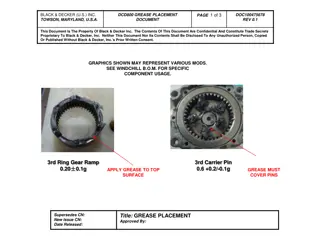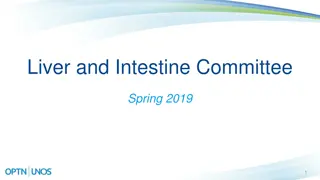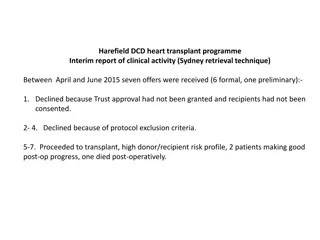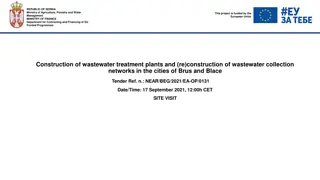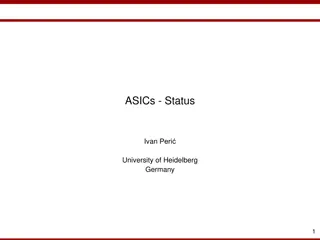
DCD and SWITCHER Chips Development Highlights at KIT ASIC Laboratory
Learn about the key developments in DCD and SWITCHER chip production at the KIT ASIC and detector laboratory in Prague in 2015. The submission plan, infrastructure details, design changes, JTAG implementation, missing codes discussion, ADC unit-cell operation, and unit-cell characteristics are covered in this comprehensive overview.
Download Presentation

Please find below an Image/Link to download the presentation.
The content on the website is provided AS IS for your information and personal use only. It may not be sold, licensed, or shared on other websites without obtaining consent from the author. If you encounter any issues during the download, it is possible that the publisher has removed the file from their server.
You are allowed to download the files provided on this website for personal or commercial use, subject to the condition that they are used lawfully. All files are the property of their respective owners.
The content on the website is provided AS IS for your information and personal use only. It may not be sold, licensed, or shared on other websites without obtaining consent from the author.
E N D
Presentation Transcript
DCD DEPFET Meeting, Prague, 2015
KIT The development/production of DCD and SWITCHER chips will be done from middle of 2015 at KIT ASIC and detector laboratory (ADL) at the Institute for Data Processing and Electronics (IPE) Infrastructure: 1. Microchip desingn software "Cadence" 2. Clean room with a fully automatic wire bonding and gold ball machine, flip-chip machine, wafer saw, etc. 3. SMD laboratory with the automatic component placer and the reflow oven Probe station will be available within next months 2 DEPFET Meeting, Prague, 2015
DCD Submission plan: UMC run on 18. May Changes in design (present status): Resize of several transistors in ADC to fix the problem of missing codes Change sampling of TDI for global and pixel register to positive edge Add fast parallel sampling mode for easier needle card tests Improve test DAC resolution 3 DEPFET Meeting, Prague, 2015
JTAG and slow controll Pixel Register PixelSel P_Shift, P_Rb, P_Ld PixelSel ShiftDR, CaptureDR, UpdateDR Address Global Register GlobalSel G_Shift, G_Rb, G_Ld Digital Block GlobalSel State M. TDO ShiftDR, CaptureDR, UpdateDR PreLoad TMS CaptureIn LatchOut DO0(7:0),DI0(1:0), ,DI3(1:0),SYNC_RES,CLK,RetCLK,TestInjEn,DO4(7:0), ,DI7(1:0) Data Register In Out ExtTest OR PreLoad CaptureIn Cont. Signals LatchOut ShiftDR, CaptureDR, UpdateDR Commands ExtTest i o Pads Instruction Register FF ShiftIR i Bitck Res The other if not ShiftIR TestMode Res! TestMode ShiftIR, CaptureIR, UpdateIR TDI TestPads ID Register FF IDSel ShiftDR&IDSel Readout Readout Reg CaptureIn CaptureIn FF FF TCK Bypass 4 Ld Full custom latches o DEPFET Meeting, Prague, 2015
Missing Codes DEPFET Meeting, Prague, 2015
ADC unit-cell The ADC-unit has two current-memory cells based on two U-I converters A and B Depending on the input current amplitude (too low or too high), a reference current (4 A per cell) will be added or subtracted The comparison is done in the following way: Two copies of the current stored in A are made this is done with the two, layout-identical, UI converters CL and CH that are connected to the same voltage as A The threshold currents are added 14u TooLow CL 12u+/-4u 10u TooHi A CH 12u+/-4u B 6 DEPFET Meeting, Prague, 2015
Unit-cell characteristics The purpose of the comparators is to assure that the reference currents are subtracted/added in the way so that the result current occupies two times smaller range Only so, we can multiply the output current by two IOut -8u -4u -2u IIn 8u 7 DEPFET Meeting, Prague, 2015
ADC unit-cell schematics In this figure, the transistor scheme of TooHi comparator is shown together with the bias currents Low PFB PFB 24u 24u RefFB 12u RefFB Sc1(5) Ith=10u Sc1(6) RefIn RefIn TooLow 24u 24u 24u 24u Sc2 Sc2 Sc2 Sc2 Original Copy 8 DEPFET Meeting, Prague, 2015
Offset Let us now assume that we have by 2 A higher current in the NMOS inside the copy U-I converter The relative current error is ~8.3% Low PFB PFB 24u 24u RefFB 12u RefFB Sc1(5) Ith=10u Sc1(6) RefIn RefIn TooLow 24u 24u 24u26u Sc2 Sc2 Sc2 Sc2 9 DEPFET Meeting, Prague, 2015
Unit-cell characteristics with offset The TooHigh-threshold is shifted IOut -8u -4u -2u IIn 8u 10 DEPFET Meeting, Prague, 2015
Bad characteristics causes missing codes This causes missing codes around 64 There are three other mismatch combinations CHI NMOS too weak (0) CLO NMOS too strong (0) CLO NMOS too weak (-64) They produce missing codes around indicated values IOut -8u -4u -2u IIn 8u 11 DEPFET Meeting, Prague, 2015
Origin of offset Why does the current offset happen? Possibility 1: transistor mismatch fix in the next chip: make the layout in a better way e.g. the transistors bigger Low PFB PFB 24u 24u RefFB RefFB RefIn RefIn TooLow 24u 24u 24u26u Sc2 Sc2 Sc2 Sc2 12 DEPFET Meeting, Prague, 2015
Origin of offset Possibility 2: poor current source output characteristics (low ROUT) Notice: two output nodes are not on perfectly same potential Original UI converter connected to amplifier input, copy UI converter to RefIn Fix in next chip: resize the current source to have better ROUT Low PFB PFB 24u 24u RefFB RefFB RefIn RefIn TooLow 24u 24u 24u26u Sc2 Sc2 Sc2 Sc2 13 DEPFET Meeting, Prague, 2015
Mismatch - simulations Left: Hi, NMOS stronger (RefIn low helps, several channels in the tested DCD) Right: Lo, NMOS weaker (RefIn high helps, one channel in the tested DCD) Left: Hi, NMOS weaker (not observed) Lo, NMOS stronger (not observed) 14 DEPFET Meeting, Prague, 2015
Statistics Pipelined ADC uses 8 double CM cells with 16 comparators in total Only if all the comparators are good the ADC works correctly Probability that ADC is fine: 16 p = p comp If p = 99.5% -> pcomp = 0.99969 3.6 sigma < 2uA Pipeline ADC MSB cell LSB cells 1 1 1 1 1 1 1 2 1 1 1 1 1 1 1 15 DEPFET Meeting, Prague, 2015
Monte-Carlo Simulation 16 DEPFET Meeting, Prague, 2015
Layout The NMOS current source has a complicated structure It is based on enclosed NMOS and a PMOS that should compensate for voltage drops (the simple version with only NMOS behaved worse on DCD1) The layout is dense The current sources in the original cell and the TooLow cell are mirrored The original cell and the TooLow cell are closer to each other this may explain why TooHigh is more often affected in the measured chip TooHigh TooLow Original cell 17 DEPFET Meeting, Prague, 2015
Layout Old New 11u 18u 18 DEPFET Meeting, Prague, 2015
Layout TIA ADC 200 m 19 DEPFET Meeting, Prague, 2015
SWITCHER Status SWITCHER Irradiation of latest SWITCHER has been done at KIT (dose 30 MRad) The chip works after the irradiation Bumping issue: bumping so far done in HD-lab, this works well for prototyping but is slow for production Bumping with the required pitch (150 m) is not offered by the vendor (AMS/IBM) Solution: Company Pactec can place underbump metallization (ENIG) and solder bumps on single dies (price < 66 Eur/chip + 7.3 kEUR ~ 16k EUR) SWITCHER submission planned in 2015 Improvements: faster clear driver Separated control of the termination resistance for serial input (should be always on) and for the other fast inputs 20 DEPFET Meeting, Prague, 2015

